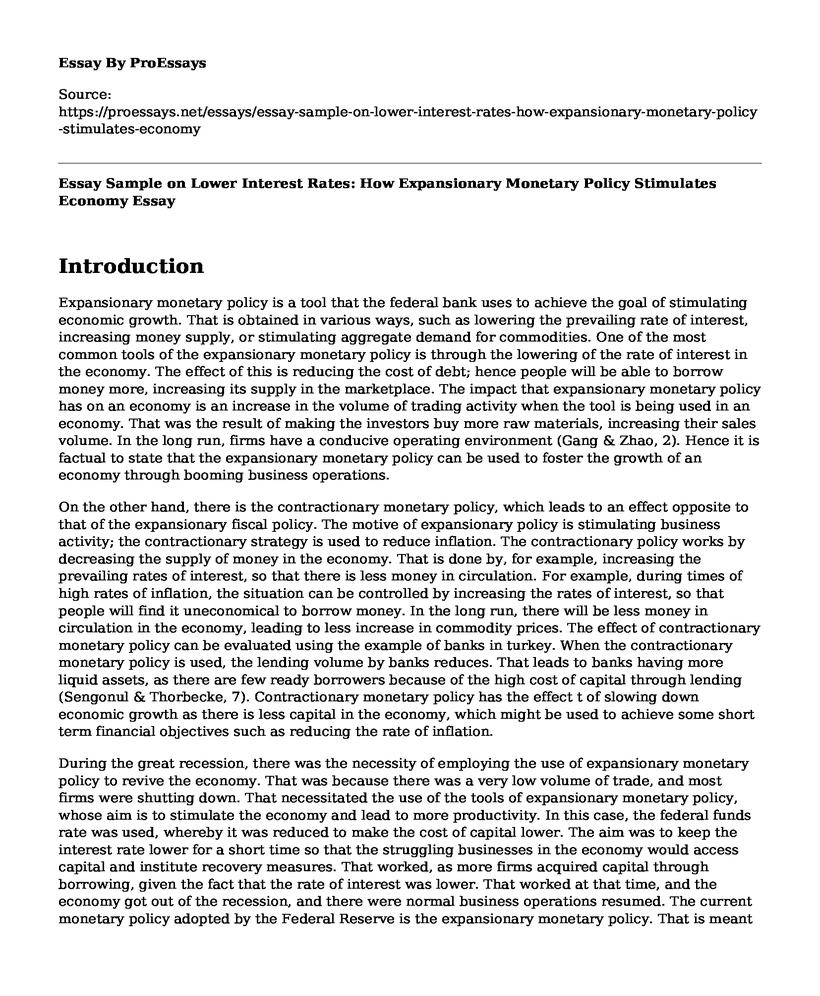Introduction
Expansionary monetary policy is a tool that the federal bank uses to achieve the goal of stimulating economic growth. That is obtained in various ways, such as lowering the prevailing rate of interest, increasing money supply, or stimulating aggregate demand for commodities. One of the most common tools of the expansionary monetary policy is through the lowering of the rate of interest in the economy. The effect of this is reducing the cost of debt; hence people will be able to borrow money more, increasing its supply in the marketplace. The impact that expansionary monetary policy has on an economy is an increase in the volume of trading activity when the tool is being used in an economy. That was the result of making the investors buy more raw materials, increasing their sales volume. In the long run, firms have a conducive operating environment (Gang & Zhao, 2). Hence it is factual to state that the expansionary monetary policy can be used to foster the growth of an economy through booming business operations.
On the other hand, there is the contractionary monetary policy, which leads to an effect opposite to that of the expansionary fiscal policy. The motive of expansionary policy is stimulating business activity; the contractionary strategy is used to reduce inflation. The contractionary policy works by decreasing the supply of money in the economy. That is done by, for example, increasing the prevailing rates of interest, so that there is less money in circulation. For example, during times of high rates of inflation, the situation can be controlled by increasing the rates of interest, so that people will find it uneconomical to borrow money. In the long run, there will be less money in circulation in the economy, leading to less increase in commodity prices. The effect of contractionary monetary policy can be evaluated using the example of banks in turkey. When the contractionary monetary policy is used, the lending volume by banks reduces. That leads to banks having more liquid assets, as there are few ready borrowers because of the high cost of capital through lending (Sengonul & Thorbecke, 7). Contractionary monetary policy has the effect t of slowing down economic growth as there is less capital in the economy, which might be used to achieve some short term financial objectives such as reducing the rate of inflation.
During the great recession, there was the necessity of employing the use of expansionary monetary policy to revive the economy. That was because there was a very low volume of trade, and most firms were shutting down. That necessitated the use of the tools of expansionary monetary policy, whose aim is to stimulate the economy and lead to more productivity. In this case, the federal funds rate was used, whereby it was reduced to make the cost of capital lower. The aim was to keep the interest rate lower for a short time so that the struggling businesses in the economy would access capital and institute recovery measures. That worked, as more firms acquired capital through borrowing, given the fact that the rate of interest was lower. That worked at that time, and the economy got out of the recession, and there were normal business operations resumed. The current monetary policy adopted by the Federal Reserve is the expansionary monetary policy. That is meant to achieve the goal of long term interest rates that are moderate, price stability, and maximum rate of employment (Labonte & Makinen, 3). The interest rate that the Fed has set as its goal is 2%, which has the objective of stimulating economic growth and reap its associated benefits.
References
Gang, Y., & Zhao, W. (2002). Monetary Policy and Financial Assets Price [J]. Economic Research Journal, 3. http://en.cnki.com.cn/Article_en/CJFDTotal-JJYJ200203001.htm
Labonte, Marc, and Gail E. Makinen. "Monetary policy and the Federal Reserve: current policy and conditions." Congressional Research Service, Library of Congress, 2008. https://fas.org/sgp/crs/misc/RL30354.pdf
Sengonul, Ahmet, and Willem Thorbecke*. "The effect of monetary policy on bank lending in Turkey." Applied Financial Economics 15.13 (2005): 931-934. https://www.tandfonline.com/doi/abs/10.1080/0960310050010225
Cite this page
Essay Sample on Lower Interest Rates: How Expansionary Monetary Policy Stimulates Economy. (2023, Apr 08). Retrieved from https://proessays.net/essays/essay-sample-on-lower-interest-rates-how-expansionary-monetary-policy-stimulates-economy
If you are the original author of this essay and no longer wish to have it published on the ProEssays website, please click below to request its removal:
- Research Proposal Sample: Relationship Between Migration and Unemployment Among Migrant in Sweden
- Paper Example on Global Food Prices on a Sugar and Dairy
- Research Paper on Globalization and Populism
- Issues Relating to Foreign Business Operations in South Africa Essay Example
- Looking Into the Profits of Capitalism: Mercari Case Study
- Exploring the Role of Behavioral Finance in Investment Decisions - Free Paper Example
- Paper Example on DRA PS-Human Resources Management







